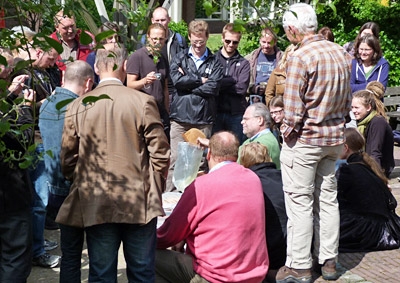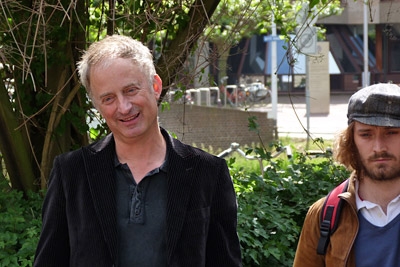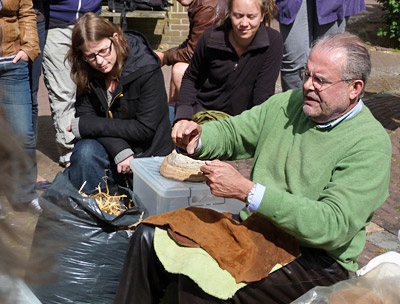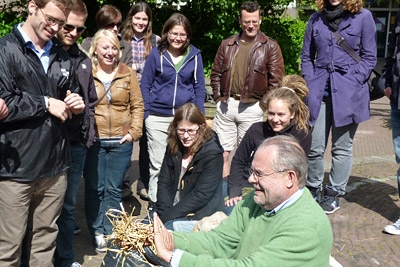Sparks on the Reuvensplaats
Making fire is no simple matter. This became abundantly clear during the demonstration by German archaeologist Jürgen Weiner. Weiner was invited by Professor W. Roebroeks to share his practical knowledge about fire. The Human Origins group of the Faculty of Archaeology organised a guest lecture and demonstration on The Earliest Fire on 27 May.
The demonstration was a great success, according to Madeleine C. van Dijk, student assistant to Roebroeks. At the first sound of flint on flint, the courtyard of the Faculty of Archaeology began to fill up with the students and professors. Jurgen Weiner was testing his fire-making tools, and his audience was fascinated to watch real fire being made.

Impatiently waiting for 'real' fire
Facts and fables

Prof. W. Roebroeks and a student
Prehistory and percussion
According to Weiner, in prehistoric times percussion was the most frequently used technique for making fire. With this technique you strike a lump of pyrite with a sharp piece of flint to produce sparks. The oldest archaeological example dates from around 32,000 Before Present (BP). The piece of pyrite showing characteristic traces of use was found in the Vogelherd cave in Germany. It is also possible that an even older piece of pyrite dating from 49,000 BP may have been found, in the Drachenloch cave in Switzerland. If it is proven that this piece of pyrite was indeed used for making fire, this would mean not only that this method is even older than had been thought, but also that the method was used by Neanderthals who lived around this period in Europe.

Jürgen Weiner showing soft, suede-like but very flammable material
Tinder fungus
Apart from these techniques and their tools, Jürgen Weiner also explained the importance of the tinderbox capturing the sparks. Although different kinds of materials are available today, archaeologically there is only one known possibility: the Tinder fungus or Fomes fomentarius. This fungus can be found in large areas of Eurasia, growing on trees, particularly the Birch (genus Betula) or Beech (genus Fagus). The Tinder fungus is well known archaeologically and the most famous example is undoubtedly the pouch with pieces of the fungus that the 5,300 year old ice mummy Ötzi had in her possession.
Flint
During the demonstration, Jürgen Weiner showed the audience a range of different materials: from pyrite to soft, suede-like and highly flammable material, made from part of the Tinder fungus. Weiner gave one of his own, much-used metal flints to Annelou van Gijn, Professor of Material Culture Studies, as a reference model for her research.

Nest of straw for the smouldering tinder
'Amazing that it's so fast'
The high point was, of course, making fire. 'Amazing that it's so fast,' was the reaction of Juliane Frost, international master's student of Palaeolithic Archaeology, of the percussion technique demonstrated by Jürgen Weiner. It was indeed amazing. With just a few strikes, he has made sparks. Using some straw he made a nest for the smouldering tinder and within a few seconds and after blowing a few times, the tinder burst into flame.
